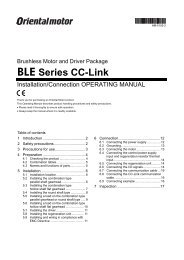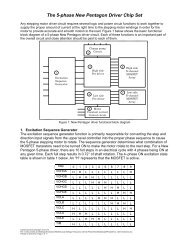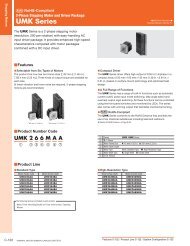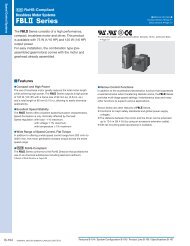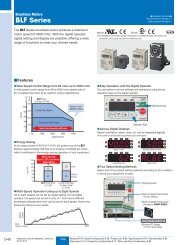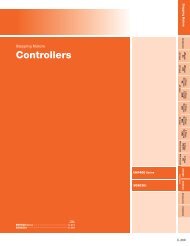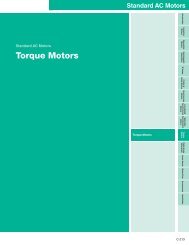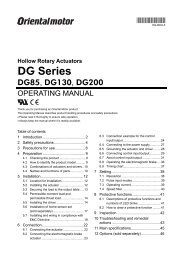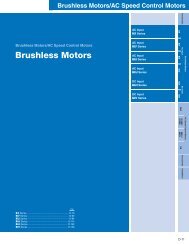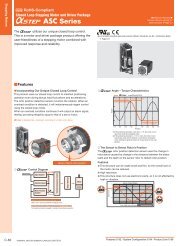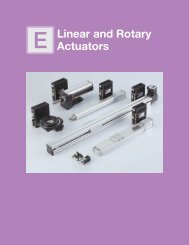Product Reference - Oriental Motor
Product Reference - Oriental Motor
Product Reference - Oriental Motor
Create successful ePaper yourself
Turn your PDF publications into a flip-book with our unique Google optimized e-Paper software.
Technical <strong>Reference</strong><br />
●Distance and Noise<br />
The noise level decreases as the distance from sound source<br />
increases.<br />
The decrease in noise level due to distance is given by the following<br />
formula:<br />
SPL2 = SPL1 − 20 log r2/r1<br />
SPL2: Noise level at distance r2<br />
SPL1: Noise level at distance r1<br />
■Overheat Protection Device<br />
If a fan in run mode locks due to overload, ambient temperature<br />
rises rapidly, or the input current increases for some reason, the<br />
fan's temperature rises abruptly. If the fan is left in this state,<br />
the performance of the insulation within the fan may deteriorate,<br />
reducing its life and, in extreme cases, scorching the winding<br />
and causing a fire. In order to protect the fan from such thermal<br />
abnormalities, our fans recognized by UL and CSA Standards and<br />
conform to EN and IEC Standards are equipped with the following<br />
overheat protection device.<br />
In the following example the noise level at a distance of 2 m (6.6 ft.)<br />
from the intake side of fan, whose noise level is 40 dB at a distance<br />
of 1 m (3.3 ft.) from the intake side of fan, is calculated.<br />
Since r2 = 2 m (6.6 ft.), r1 = 1 m (3.3 ft.), and SPL1 = 40 dB,<br />
substituting in the formula gives:<br />
SPL2 = 40 − 20 log 2/1<br />
= 34 [dB]<br />
Thus, at a distance of 2 m (6.6 ft.), the noise level decreases by 6 dB.<br />
The value 20 log r2/r1 in the above formula represents the ratio<br />
between two distances. Thus, if the values used above were 3 m<br />
(9.8 ft.) and 6 m (19.7 ft.), the result would have been the same.<br />
Therefore, if the noise level at a certain distance is known, the noise<br />
level at another distance can be estimated.<br />
■Capacitor<br />
Permanent split capacitor motors contain an auxiliary winding offset<br />
by 90 electrical degrees from the main winding. The capacitor is<br />
connected in series with the auxiliary winding, causing the advance<br />
of current phase in the auxiliary winding.<br />
<strong>Motor</strong>s employ vapor-deposition electrode capacitors recognized by<br />
UL. This type of capacitor, which uses a metallized paper or plastic<br />
film as an element, is also known as a "self-healing (SH) capacitor"<br />
because of the self-healing property of the capacitor element.<br />
Although most of the previous capacitors used paper elements, the<br />
plastic film capacitor has become a mainstream model in recent<br />
years due to the growing demand for compact design.<br />
●Capacitance<br />
The use of a capacitor with a different capacitance may cause<br />
excessive motor vibration and heat generation or may result in<br />
torque drops and unstable operation. Be sure to use the capacitor<br />
included with the fan. The capacitor's capacitance is expressed in<br />
microfarads (μF).<br />
●Rated Voltage<br />
Using a capacitor exceeding the rated voltage may cause damage<br />
and then smoke or ignite. Be sure to use the capacitor included with<br />
the fan. The rated voltage of the capacitor is expressed in volts (V).<br />
The capacitor's rated voltage is indicated on the surface of the<br />
capacitor case. Take proper precautions, since the capacitor's rated<br />
voltage is different from that of the fan.<br />
●Rated Conduction Time<br />
The rated conduction time is the minimum design life of the<br />
capacitor when operated at the rated load, rated voltage, rated<br />
temperature and rated frequency. The standard life expectancy is<br />
25000 hours. A capacitor that breaks at the end of its life expectancy<br />
may smoke or ignite. We recommend that the capacitor be replaced<br />
after the rated conduction time.<br />
Consider providing a separate protection measure to prevent the<br />
equipment from being negatively influenced in the event of capacitor<br />
failure.<br />
●Thermal Protector<br />
The MRS Series, MB Series (impeller diameter ϕ80 mm (3.15 in.) or<br />
more) and MF Series fans contain a built-in automatic return type<br />
thermal protector. The structure of a thermal protector is shown in<br />
the figure below.<br />
The thermal protectors employ bimetal contacts, with solid silver<br />
used in the contacts. Solid silver has the lowest electrical resistance<br />
of all materials, along with a thermal conductivity second only to<br />
copper.<br />
●Operating Temperature of Thermal Protector<br />
open 120±5˚C (248±9˚F)<br />
close 77±15˚C (170.6±27˚F)<br />
(The fan winding temperature, where the thermal protector is<br />
activated, is slightly higher than the operating temperature listed<br />
above.)<br />
Bimetal<br />
Lead Wires<br />
Solid-Silver Contact<br />
Fig. 14 Structure of Thermal Protector<br />
●Impedance Protected<br />
The MU and MB Series (MB520 and MB630 type) fans are<br />
equipped with impedance protection.<br />
Impedance protected fans are designed with higher impedance in<br />
the fan windings so that even if the fan locks, the increase in current<br />
(input) will be minimized and the temperature will not rise above a<br />
certain level.<br />
F-72 ORIENTAL MOTOR GENERAL CATALOG 2009/2010



